Gramophone Company Matrix and Catalog Numbers
By Howard S. Friedman
Table of Contents
See Also:
- Matrix and Catalog Numbers in G&S Discography
- Victor's Use of Matrix Numbers
- Matrix Numbers in Recordings of Gilbert & Sullivan
- Summary of Recording Histories
Gramophone Company Matrix Numbers
Early Numbering Systems
Between 1898 and 1921, some 200,000 different recordings were made. Recording sessions supervised by the first eight recordists of the Gramophone Company and its successors account for nearly 160,000 of these recordings. A method obviously was needed to give each plate a positive and unique identification. Several early systems were proposed and used, but the volume of discs being produced outlived the practicality of nearly all of these systems.
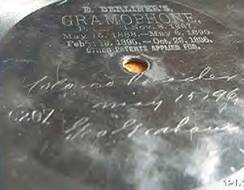 |
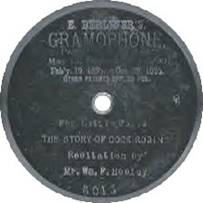 |
|
| Berliner 620z, May 15, 1896 | Berliner 6015, before Feb 22, 1899 |
The initial system was the obvious one: Gaisberg and the other recordists simply wrote the required details in the blank space in the center of each plate (see above), there being no paper labels at the time. These details, together with the title (Berliner or Gramophone), the Trade Mark of the Recording Angel (precursor of Angel Records) and Catalog Number added afterwards, then appeared on every pressing from a given matrix, since the plate itself bore the markings in mirror writing. These discs also showed the dates of Berliner's five patents (see above), which did not include the gramophone patent No. 564,586. This practice continued until the advent of discs with paper labels in January, 1901.
Bennett lists a few 7-inch Berliner discs recorded as early as October 29, 1895. (However, for a possible 1890 recording, see part 4 of this article.) These were probably made in Philadelphia. Symposium Records, in their liner notes for Symposium CD 1058, provide transfers of 39 selections issued under the Berliner label between 1890 and 1901. Four of these purport to have been recorded "c1890." Read and Welch (p.124) confirm that hard rubber discs are known having etched recording dates as early as 1896, and bearing the type-face etched title "Berliner's Gramophone Co., Washington, D.C.," which can be seen in the photo to the left above. Bennett also states that recordings before 1898 can be presumed not to be of London origin.
Berliner established the Berliner Gram-o-phone Company in Montreal, Canada, probably in late 1896. Numerous discs exist from this period and venue, as shown below. All have the patent date February 24, 1897. In addition to the labels shown above, several other variations are known.
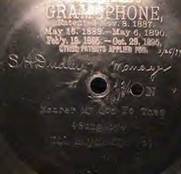 Showing the 5 patent dates |
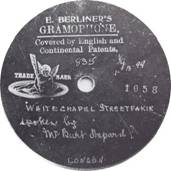 Early use of the Angel trademark, 1899? |
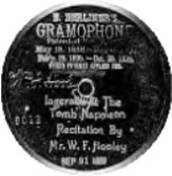 Berliner with no apparent disc number, dated in 1899 |
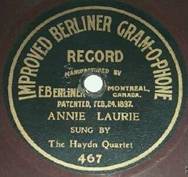 Berliner 467 |
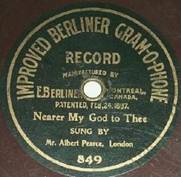 Berliner 489 |
 Berliner 871 |
Recordings before November 1898 (August 2, 1898, according to Alistair Cooke) through 1900 were on 7-inch matrices only. The first known 10-inch recordings were made in London in April-May 1901, although the first known 10-inch matrix numbers date from recordings made in St. Petersburg in June 1901. Recording on 12-inch matrices began possibly as early as April 1902, although no numbers are yet known prior to early February 1903, from nine recordingsvunder the supervision of Fred Gaisberg (matrix numbers 10-18) made in San Remo, Italy. (See Perkins, Ward, and Kelly.)
The reverse side of single-sided discs often contained such additional information as the words of the selection, the celebrity status of the artist(s), as well as advertising of forthcoming recordings! Alternatively, it bore a large incised impression of the Recording Angel trademark. According to various sources, records made between the Gaisbergs' arrival in London in late July and November 1898 (however, see below) were not identified in any other way.
Commercial recording began in London on August 2, 1898, almost immediately after the Gaisbergs arrived. Between that date and November 1, no matrix or serial numbers of any kind were assigned to recordings, which were listed by catalog number only. Matrix numbers were introduced on or about November 1, 1898 (although they may have been used earlier). Each matrix plate was identified by a single number, which sometimes was modified by a prefix containing both numbers and letters, or by a suffix of similar makeup, or by both. The matrix number alone provided information as to who, what, and generally when, while the prefixes and/or suffixes, if any, indicated where and how. Either the prefix or the suffix or both could be separated from the main number by a hyphen. The suffix could contain either normal or superscript Roman or Arabic numerals.
To deal with these three sizes, a simple system was devised to distinguish the sizes, the different number series that might be used for each size, and the recordist in charge of the actual recording procedure. The 7-inch and 10-inch matrix numbers assigned before the introduction of the letter triplet system (below) were bare numbers, known as the unlettered series. Fred Gaisberg himself took the block of numbers from 1 to about 12000. However, if he used the same number for different size discs, it would be the latter-day discographer who could not distinguish them.
Between 1898 and 1900, an unlettered number series was used, the lowest known entry, No. 19, being Catalog Number E1026, recorded November 1, 1898. However, Bennett lists numbers as low as 1000, recorded on August 15, 1898, which probably had E prefixes. The last known number was No. 2079, Catalog Number E6288, recorded in London May 10, 1899. This, the original unlettered series, was recorded entirely in London by Fred Gaisberg, and often bore the suffix FG.
(Note: Berliner Catalog Number E1026 is known to be by Hawthorne, but it is listed in Bennett without the prefix. Bennett lists numerous bare matrix numbers as high as 13915, recorded in 1914. These are apparently errors in transcribing any suffixes present to numbers higher than 2079, as well as to omitting the E prefix from that series. Bennett lists many of H. Scott Russell's recordings of 1900-1901, for example, with bare matrix numbers that correspond directly with numbers listed in Wolfson as having the a suffix.)
Prefixes, Suffixes, and Triplets
Following the introduction of the all-wax process, a new series of matrix numbers appeared to distinguish these recordings. This involved the use of the J (for Johnson) prefix, the earliest known example being J558, Berliner 2749, dated May 3, 1900. By August 21 of that year the J prefix had disappeared.
The adopted system involved, initially, eight sets of lower case letter triplets. In this way it was relatively easy to identify the selection and the artist(s), the size of the record, and the recordist in charge. Fred Gaisberg took for himself the triplet a/b/c. His brother Will used d/e/f, while William Sinkler Darby was assigned g/h/i, as well as j (and later shared ad/ae/af with Edmond J. Pearse). Franz Hampe had k/l/m, and Max Hampe was given q/r/s. The assignees for the n/o/p and t/u/v triplets were probably Cleveland Walcutt (later Joseph Sanders, George Dillnutt, and John D. Smoot), and Charles Scheuplein (later Fleming), respectively. Arthur S. Clarke received x/y/z. w is the only letter not having a series attached it.
As the only recording location at this time was London, it was not thought necessary to identify the plates with anything more than a simple number. The first problem was to identify the use of 7-, 10-, and 12-inch records. Moreover, as additional recordists were added to the staff, Gaisberg not only sent them all over the world to record the great and small celebrities of the time, but he also pre-assigned blocks of matrix numbers to them.
As more recordists were added or number blocks were exhausted, additional triplet series were made, simply by adding a to the first series, thus aa/ab/ac, ad/ae/af, and so forth. At least 16 different G&T Company recordists have been identified and associated with their respective triplets This took the suffixes from a through z, and from aa through az, Belford Royal, a close friend of Eldridge Johnson, who had sent him to London to supervise the assembly of the gramophone parts he had sent, was given the suffix R, rather than start a b- series. Bennett lists many records having matrix numbers with the R suffix, from as low as 37R in June 1903 up to 268R in early 1904.
The triplet system began to take effect at the end of 1903, following the assimilation of the previously independent International Zonophone Company. The recordists continued to use their individual matrix number blocks, but now added their own unique suffixes. The reader will find numerous matrix numbers on recordings made before the introduction of the triplet letter system listed with various suffixes. When the company stopped making 7-inch discs, about the end of 1906, it was then necessary to assign only two doublet suffixes to each new recordist.
Gaisberg and other recordists made frequent tours throughout the world. From May 1899 to about August 1900, they used a number block from 2124 through 5041, which constituted the second unlettered series. The recording engineer was often identified by having his initials added as suffixes in upper case to each matrix number. Gaisberg himself used G or FG, occasionally also in lower case (confusion!). His brother Will used W, WG, or WCG, and even W2 and WII. Bennett lists matrix numbers such as WCG.3974-R and 4614.FWG as late as January 1904. By March 1904, we find matrix numbers such as 4650b, indicating early use of the triplet system. The unlettered series ended at some point above 5000 (Bennett lists 6320 in October 1904), but was revived later to accommodate 7-inch records whose 10-inch counterparts already used the b series. Bennett lists the 9 recordings made in March 1902 by the great French bass singer Pol Plançon. All of these have matrix numbers with the suffix G, showing the late usage of this particular suffix.
Numerous exceptions, omissions, and errors exist, especially by the chief recordist, Fred Gaisberg. Between September 1902 and August 1903, he toured the Southeast Asia area, at which time he introduced his own personal block of E numbers, using E100 to E868 for 10-inch discs, and E1000 to E2189 for 12-inch discs. Not all the basic numbers were used, since he frequently began a new recording session or series with a round number, regardless of the last number used. These E numbers are not to be confused with the double-sided discs made after 1912. The latter were 10-inch discs, and included such artists as Ruth Vincent, George Baker, Edna Thornton, Harry Dearth, John Harrison, and others associated with the earliest Gilbert and Sullivan recordings.
It is important to note that all of the recordists used the same numbers. Only the suffixes were different, and they identified not only the recordist in charge, but eventually the date and place of the recordings. For example, during the period from November 1903 to January 1905 Fred was using the numbers 4601 to 6533 in the 10-inch series, that is, with b suffixes. During this same period, his brother Will was using 403 to 1593, but with e suffixes for the 10-inch sides. Again, Fred used 3000 to 4320 from February to November 1903. Will did not use these numbers until October 1905 through May 1906. This is why the suffixes during these early years are so important, and should never be omitted when describing or listing matrix numbers.
Another curious usage occurred when Will Gaisberg spent the winter of 1903-4 in Milan with the intention of recording the artists present. For this series he used matrix numbers from Con 1 for 7-inch discs, from Con 100 for 10-inch, and from Con 500 for 12-inch discs. Presumably, the Con prefix indicated the Continental Hotel, where he was staying! When the triplet system was introduced in late 1903, these matrix number series were converted to 1d. 100e, and 500f. This practice was often applied to plain matrix numbers assigned by other recordists as well.
The acoustical recordings for which Fred Gaisberg was responsible are easily recognizable: the matrix numbers have either a, b, c, G, or FG suffixes. The highest numbers traced are 7496a, 20682b and 3503c, totaling over 31,500 recordings in some 20 years. During this period, Fred's brother Will was responsible for nearly 34,000 recordings. The recordist William Sinkler Darby, on his first European tour in 1899, covering some 13 European capitals from Madrid to St. Petersburg, produced no fewer that 2,450 zinc matrices!On April 11, 1902, in a private drawing room on the third floor of the Grande Hotel in Milan, Fred Gaisberg paid Enrico Caruso the then princely sum of £100, about $500, in spite of objections from the home office in London, to record ten sides that would literally shake the record making industry and the record buying public off its rather shaky perch! (Gelatt (p. 114), Read and Welch (p. 143), and Fagan and Moran (p. xlvii) all say March 18; Moore and Bolig confirm April 11.)
Earlier, in mid-1900, Gaisberg had traveled to St. Petersburg to record the great Russian basso Feodor Chaliapin, who was to become, among many other great musical artists, his lifelong friend. He was unsuccessful, and it was not until a few weeks before the Caruso recordings that the recordist Arthur S. Clarke succeeded in recording Chaliapin. These ten recordings were apparently made with zinc matrices, the obvious inference being that blank zinc plates traveled much better than wax plates! However, the Caruso recordings appear to have been made on wax plates, which Gaisberg carried personally to Hanover, Germany, where the stampers were made and the discs were pressed.
Since the letter triplet system was not initiated until about August 1903, the matrix numbers assigned to the Caruso recordings, as well as many others of the years 1902-3, were probably unlettered numbers. Thus, Bolig lists the matrix numbers for the April and November 1902 Caruso recordings without suffixes. Yet the Seraphim and Everest reissues both lists these twenty recordings with b suffixes. It seems probable that, after the introduction of the triplet system, many, if not all, earlier matrix numbers were updated by having a suffix a or b or c added! Many 1902-3 recordings listed in Bennett have the b suffix.
The original triplet system continued until about 1912, in some instances as late as the end of 1916. In 1912 it was modified by the introduction of the prefix HO. Considerable controversy surrounds the meaning and significance of HO. Some say that it indicated "Home Office," others that it stood for Holmes, the recordist in charge, and still others for Holmes as the innovator of a new recording technique. The second theory is implausible since, according to the system, Holmes the recordist would simply have been assigned a new triplet. Regardless of its origin, its use initiated an entirely new series of matrix numbers, rather like starting all over again. The lowest number known to me is HO116ae, indicating that the recordist was Edmund J. Pearse.
Later Gramophone Company Matrix Numbers
The Recording Sessions table under the 1921 HMV Patience shows that the HO/triplet system was dropped sometime between January and June 1921, and a new matrix system using the Bb/Cc prefix system, for 10- and 12-inch discs, respectively, was adopted. No change was made in the method of designating take numbers. The Bb/Cc prefix system was used until about late 1930, when it was replaced by an even more complicated system of alphanumeric prefixes, including 0B, 2B, 0E, 2E, etc. (discussed below). Apart from their place in the history and development of matrix numbers, they are of small interest here, except perhaps as a bookmark for recording dates.
In January 1931 the third system was introduced, using 0A/2A, 0B/2B, up through 0Z/2Z for 10-inch and 12-inch matrices respectively. These were used through 1934, often more than one series being used simultaneously. The fourth and final system, lasting up until the end of the 78 rpm era in 1954, consisted in adding another letter to the prefix, thus 0AA/2AA, 0AB/2AB, 0BA/2BA, and so forth, similar to the method used to expand the letter triplet system. The 0BA/2BA, 0EA/2EA, 0LA/2LA, and 0RA/2RA series are known. These are seen only on His Master's Voice double-sided discs. The matrix number itself, with the prefix, usually appeared on the record label, without take suffixes, which during this period were hyphenated Arabic numerals. It is the writer's conclusion that the O and 2 series, which were used by RCA until the end of the 78rpm era, were derived from 10 and 12 inch discs.
The same basic matrix numbers may, indeed occasionally do, appear with both prefixes, on 10- and 12-inch discs, respectively. At the beginning of the electrical recording era, about April 1925, Victor began imprinting a V.E. in a circle near or over the matrix number of imported electrical recordings, below the label of all such recordings. When electrical recordings replaced acoustical performances, it was common to use the same basic matrix number, and to replace Bb or Cc with BVE or CVE. The reader should note the difference between a matrix number with a V.E. overprint stamp, and one with a BE or CVE prefix. The former are electrically amplified or re-recorded from the original matrix, while the latter are new electric recordings.
During the period 1921-1924, certain major celebrities were given special prefixes to identify them. Thus, Luisa Tetrazzini was given the BB prefix, although these were never published. The great baritone Mattia Battistini, who had been recording since 1902, was given BA and BK, and CA and CK prefixes for his 10-inch and 12-inch 1921 recordings, respectively. The basso Feodor Chaliapin was given BF/CF and BR/CR, while Ezio Pinza used BE/CE and BK/CK. Tito Schipa was given the prefix BM.
Matrix numbers on the records themselves appeared either raised or incised. From my own observations, matrix numbers using the triplet system the Bb/Cc system described below were generally incised. That is, they were stamped onto the original matrix before the stampers or masters were prepared. Matrix numbers in the HO/triplet system, on the other hand, appear to have been stamped onto the stampers themselves, using reverse dies. All HO/triplet matrix numbers that I have seen are raised on the records themselves.
G&T Catalog Numbers and Record Labels
To correlate the development of recording and playback equipment with the application of matrix numbers, one must consider also the evolution of the labels used by the various companies during their periods of growth and change. One should also note that many sides recorded as early as 1900 were issued as late as the end of the acoustical era, even on double-sided discs. It is therefore not uncommon to find the same selection on discs with the same catalog number but different labels.
G&T record labels fall into some seven different categories: 1) pre-label Berliner and Gramophone Co.; 2) Gramophone & Typewriter Co,. Ltd., and Sister Companies Concert and Monarch series; 3) pre-Dog Gramophone Co., Ltd.; 4) Gramophone Co., Ltd., with the Dog trademark; 5) His Master's Voice, large and small trademarks; 6) HMV B, C, D, and E series; and 7) HMV DA and DB Celebrity series. Most of the labels were printed in different colors to identify price categories. In addition, a dark green label was used for lesser recording lights, for both 10- and 12-inch discs, from as early as 1909 to 1921 or later.
Records made by the Gramophone Company between 1895 and December 20, 1900 were labeled either Berliner or Gramophone discs or both (see below), the details being etched into the matrix as described previously. From January 1901 until 1907, the discs were labeled Gramophone, using paper labels, and from 1907 until 1912 they were called Gramophone & Typewriter discs.
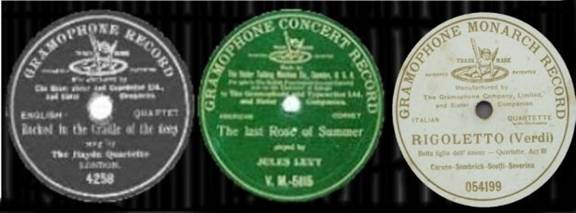 Left: Gramophone Record 4258, 7-inch, issued early in 1903. Bennett lists 7-inch sides as late as December 1905. Center: Gramophone Concert Record V.M. 5115, 10-inch. Right: Gramophone Monarch Record 054199, 12-inch, recorded February 7, 1908. |
In January 1902, the first Gramophone Concert Record labels appeared on 10-inch discs. The Monarch designation for 12-inch discs was used from as early as June 1903 to as late as 1924. Red labels were introduced as early as March 1902 for both size discs. These generally indicated the more outstanding performers, e.g., Caruso, Plançon, De Luca, Ancona, and Scotti, while less well known artists were given black labels.
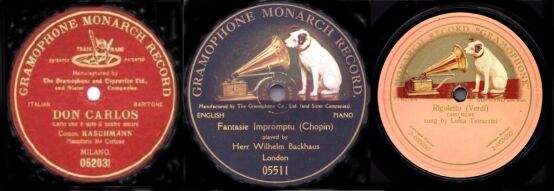 Left: Gramophone & Typewriter Company, Ltd., pre-Dog Monarch 052031, recorded in 1903. Center: Gramophone Dog Monarch Black 05511 above was recorded in late 1908, but was not issued with the Dog trademark until August 1910. Manufactured by The Gramophone Co., Ltd. and Sister Companies, the latter phrase being in parentheses. The first double-sided black label "Concert" and "Monarch" discs appeared in September 1907. Right: Gramophone Dog Monarch Pink 2-053050, recorded by Luisa Tetrazzini in New York, 1911. Note the double catalog number. The Concert and Monarch labels were replaced by the "His Master's Voice" style in August 1910. |
 All of the above have THE GRAMOPHONE CO., LTD. labels. The two shades of pink (Feb 11, 1906 and 17 Mar 1907 and the green label (April 3, 1914) were assigned to Caruso, while the orange was assigned to Battistini. The various colors assigned to these and other artists changed from time to time, and were generally based on the expected popularity, and hence price per disc, of the artist concerned. |
Double-sided black label discs in both sizes appeared in September 1907. The "Angel" trademark was still in use in February 1910, to be replaced in August 1910 by the "His Master's Voice" trademark. Discs issued before the use of the HMV or Dog trademark are known as pre-Dog discs. Between August 1910 and February 1911, both trademarks usually appeared on G&T labels. Some time after August 1910 the Gramophone Company titles were all changed to "His Master's Voice," placed above the trademark.
 Left: In March 1904, in the drawing-room of her mansion on Cumberland Place in London and under the supervision of Fred Gaisberg, Nellie Melba recorded 16 arias. One of her conditions for recording was that her issued records have a distinct and unique color label, in this instance, mauve (actually, lilac). G&T 03033 above was from the second session in October 1904, when she was accompanied by the great violinist Ian Kubelik This recording bore the matrix number 401c. Melba would remake this selection for Victor in New York in early February 1905. Center Left: Gramophone Monarch 054199, pale green label, recorded in New York, February 7, 1908. Center Right: This Monarch label has the same configuration as that shown above for the Monarch 2-053050 pink label, except for the black label. Right: This SCHALLPLATTE GRAMMOPHONE 052122 disc is stamped "Made in Germany" outside the left side of the label. Recorded originally in New York on February 11, 1906. |
The Gramophone Company used a rather complex system for assigning catalog numbers to their discs. This involved the use of a 5- or 6-digit number. Counting from the right, a zero in the sixth position indicated a 12-inch record, while its absence indicated a 10-inch record. The fifth position was used to indicate the language of the recording, i.e., 2=Russian, 3=French, 4=German, 5=Italian, 6=Spanish, etc. The digit fourth from the right indicated the voice or instrument, as 2=male, 3=female, 4=concerted, 5=piano, 7=violin, and so forth. This system appears to have been in effect from the first recording of Syria Lamonte in November 1898, and was used consistently throughout the period of single-sided discs.
From what one can gather from such references as Bolig, if the language was English (1 in the fifth position), it was omitted altogether and a 4-digit number was assigned. If the English recording was a 12-inch disc, the zero would occur in the fifth position. This system took no account of the record size, and number sequences could encompass 10-, 12-, and even 7-inch discs.
This system provided a block of 1000 recordings for a given set of third, second, and first numbers, i.e., from 000 to 999 in the first, second, and third positions. When the block was exhausted, a new series was begun by prefixing the numbers with 2-, 3-, 4-, and so forth, as necessary. Thus, the 2000, 3000, and 4000 series of G&T records were all vocal recordings in English. Recordings in Russian would encompass the 22000, 23000, and 24000 blocks, and so forth.
G&T introduced the "B" and "C" series of 10- and 12-inch double-sided discs in late 1912, using plum labels for both series. The 12-inch "D" series was not initiated until February 1918, while the 10-inch "E" series were issued the following year. Both series were issued with black labels. Single-sided discs, nevertheless, continued to be issued until about the end of the acoustical era.
(Concerning the recent compilation by Michael Smith, this extremely valuable work lists all of the 2112 "D" series and 610 "E" series discs. HMV D1 was released in February 1918, and E1 was released in July of that year. The last "D" series was issued in November 1933, and the last "E" series was released in October 1930. Each listing consists of the disc number, a single-disc or serial number, the matrix number, and the recording date. This is followed by the selection itself, including the performer(s). Many of the disc numbers in the left-hand column have one or two dates beneath them. Dates without parentheses are assumed to be dates of issues, while those in parenthese are assumed to be the date when the issue was withdrawn from the catalog.
The second column contains either a single-disc or serial number. Unfortunately, Smith provides no explanation of any of the column entires, and one must conjecture for one's self. It is known that many double-sided discs in the "B", "C", "D", and "E" series were reissues of previously or even concurrently issued single-sided discs. The latter were issued as late as 1924. At the same time, most "D" and "E" discs were issued only as double-sided discs. However, the practice of assigning single-side numbers continued as late as 1929.
Some time around 1928 it became the practice to assign serial numbers to recordings in the order in which they were accepted in the various recording sessions. These numbers took the general form of nn-nnnx, where the first pair of numbers were 32, 42, or 52. The significance of the different series is unknown. The numbers following the hyphen were generally sequential, in order of their acceptance. For the "E" series, the first numbers were 30, 40, 50, or 60. The obvious conclusion is that the "2" indicated 12-inch, and the "0" indicated 10-inch sides, as used in later matrix numbering systems.
The third column gives the matrix number. Smith states HO numbers as Ho. However, this is quite incorrect. The records themselves indicate clearly that the HO form was always used.
The fourth column is the recording date; only a few are missing. Among the earliest single-side reissues is John Harrison's "A wand'ring Minstrel I," from the 1906 Mikado recording on G&T 02073. This was reissued on HMV D242, the second side being Harrison's recording of "Thora," by S. Adams. The earliest single side reissued on HMV is Edvard Grieg's 1903 recording of is own "Au Printemps," issued originally on G&T 355110. The matrix number is 2147f, indicating that the recording was supervized by Will Gaisberg. Perkins et al. show this matrix number to have been used in 1907 in London.
The fifth and last column lists the selection(s), and the performer(s). In many instances sets were available as single discs. In these instances the dates of withdrawal are given for the individual discs. Where the entire set was withdrawn, the date is given under the last selection listed for the set.
In addition to the complete listings, this publication provides cross references of disc numbers in manual, automatic, and duplicate automatic recordings for both series. A listing is also provided of all of the discs recorded by each artist, as may be found in all of Bennett's books.)
 Left: HMV B. 9561, a 10-inch double-sided disc electrically recorded. The matrix number 0EA. 10963 can be seen at the bottom of the label. Center: HMV C. 1406, a 12-inch double-sided disc electrically recorded. Note that the label on this side is 3-3/8", while that on the reverse is only 2-7/8". Right: The Dog trademark usually appeared on the label in the language of the country where it was recorded. Thus we have "La Voix de Son Maître," "La Voce de la Padrone," and "Schallplatte 'Grammophon'." The title of the selection was often printed in the same language as that of the trademark. La Voce del Padrone DB 641, recorded in New York, September 12, 1923, shows the original single-sided disc number 2-053217 at the left. This label is about 3" in diameter, while those of acoustical discs are generally 3½". |
In an earlier day, such celebrities as Dame Nellie Melba were accorded a label color of their own, hers being mauve (actually, lilac). In August 1907, Caruso's recording of the quartet from Rigoletto was issued by G&T with a pale blue label, while his duets with Antonio Scotti had pale green labels. Battistini was accorded orange labels, while Patti and Tetrazzini received pink labels. The run-of-the-mill (!) artists, such as De Lucia, Giorgini, Ruffo, Journet, Boronat, Galvany, and others were all issued with the standard red labels. In August 1908 Caruso recordings were being issued with white, blue, green, and pink labels. All this was done in order to assign the various recordings to different price categories! The approximate order in increasing price was red, orange-lilac-pink, green, blue, and white. These colors appeared in varying shades, due to the difficulty of preparing batches of inks of the same hue.
 Left: Showing the Recording Angel and His Master's Voice trademarks. Recorded in New York, January 19, 1912. Note the color variations in the background of the "His Master's Voice" trademark. Center Left: Showing the GRAMOPHONE CO., LTD. Title with the His Master's Voice trademark. Recorded in New York, April 3, 1914. The green label was used for pricing. Center Right: Showing the Gramophone Co., Ltd title with the His Master's Voice trademark. Recorded in New York, March 17, 1907. Right: HMV V.B. 57, reissue of matrix C 2341, recorded on February 27, 1905. The A matrix number is printed at the bottom. |
The Celebrity series were first given DA and DB letters in August 1924. together with all the old single-sided numbers. The latter were shortly dropped from the catalogs. By December of the same year, the DJ, DK, DM, DO, and DQ series had been introduced, again for pricing purposes. At this time the principal celebrity label color was red.
 Left: HMV D.K. 119 with the Recording Angel. The speed is indicated as 78, while the reverse selection is given as 82. Note the small His Master's Voice trademark, above which is the statement, "This record is listed in Catalogue No. 2 which contains records of unique and historical interest not included in general record catalogue." All of the labels above have "Record manufactured by THE GRAMOPHONE CO., LTD., Hayes, Middlesex, England" around the outside of the ring at the bottom. Center Left: This single-sided HMV 2-054049 shows the logo of the Gramophone Company, Limited. This unusual disc shows the Victor catalog number 89075 incised above the label at the 12 o'clock position, the matrix number A14272 in raised characters at 6 o'clock, a small "1" at 9 o'clock, and a raised "R" at 3 o'clock. In addition, a raised G&T number 2-054049 can be seen underneath the top of the label. Center Right: The double-sided HMV D.O. 101 has the "Droite de Reproduction" logo. The D.D. series were the most expensive of the 12-inch HMV discs. The latter appeared only on one side of double-sided issues. Right: The single-side version of "Addio dolce Svegliare" on HMV 054204 has the GCL logo. |
From 1912 until at least the end of June 1924, single-disc numbers were assigned to each side of most of the now double-sided discs, although it is highly unlikely that single-sided discs were ever issued again. However, single-sided discs continued to be issued throughout the remainder of the acoustical era. When these were reissued on double-sided discs, as many of them were, the issuance of the single-sided version was discontinued. Bennett lists many of these sides under single-side numbers. In fact, the writer has checked the original disc labels or photographs thereof, of every acoustical set from the 1917 Mikado through the 1936 HMV Mikado. Every side in every set has a single-side disc number imprinted on the label at the left (but see below).
In addition to the single- and double-side catalog numbers that appear on HMV labels in the first electric series, there appears another series of numbers, usually loacated under the double-side catalog number. These numbers are in sequence in each set. Their significance is not known at this time.
The labels on the Victor reissues in the first electric series reveals a series of numbers under the catalog number at the right. Some of these are in parentheses, some are not. These numbers are sequential within each set. It is not known whether the Victor numbers were meant to indicate single-side discs. The single-disc numbers on the HMV double-side discs, on the other hand, are entirely random. Of the three series of G&T numbers, that is, the matrix number, the single-side disc number and the double-side number, no sequence correlates with either of the other two. Moreover, G&T appears to have used this random number system on various discs in the electric DB series.
The Victor Red Seal release of the 1928 Yeomen of the Guard shows two sets of numbers in parentheses below the record numbers on the labels. These run from 11220-A through 11230-B, indicating 11 double-sided discs from the manual coupling, and from 72381 through 72402, indicating 22 single-sided discs, which were never issued.
The only set which the writer has for comparison is the G&T issue of the 1927 Trial by Jury, catalog numbers D7507/10, which is the drop auto coupling, and the Victor riessue in album C-4, catalog numbers 9314/17, manual coupling. A comparison of the single-side numbers is shown in the table below:
| Matrix Number | HMV Numbers | Victor Numbers | ||
|---|---|---|---|---|
| Double- Side | Single- Side | Double- Side | Single- Side ? | |
| Cc11602-2 | D7507-1 | 2-04639 | 9314-1 | 47392 |
| Cc11603-2 | D7507-2 | 2-04640 | 9314-2 | 47393 |
| Cc11604-2 | D7508-2 | 2-04641 | 9315-2 | 47395 |
| Cc11606-2 | D7510-1 | 2-04642 | 9317-1 | 47398 |
| Cc11606-2 | D7510-2 | 2-04660 | 9317-2 | 47399 |
| Cc11644-2 | D7508-1 | 2-04643 | 9315-1 | 47394 |
| Cc11645-2 | D7509-1 | 2-04644 | 9316-1 | 47396 |
| Cc11646-1 | D7509-2 | 2-04645 | 9316-2 | 47397 |
Conclusion
From about October 1898 until the advent of long-playing recordings, the matrix number was basically just that, a number. The number itself identified the artist(s) and the selection(s), as well as the recording date, if written records were kept. During the first half of the last century, numerous prefixes and suffixes were added, to identify each performance as completely and uniquely as possible. The suffix triplets identified the size of the record, as well as the recordist or recording engineer.
From the above discussion, one can identify five systems for numbering Gramophone Company matrices. The first used plain unlettered numbers, then the letter triplet system followed by the HO/letter triplet system. The Bb/Cc system and the 0A/2A system with its adjunct 0AA/2AA system followed this. After the introduction of tape recording, all of these early matrix number systems passed into history.
For a more exhaustive discussion of the problems of early matrix numbers, the reader is referred to the article "On Gramophone Company Matrix Numbers" by John F. Perkins, Alan Kelly, and John Ward, which appeared in the British magazine The Record Collector, Vol. XXIII, Nos. 3 & 4, May, 1976.
Victor's Use of Matrix and Catalog Numbers.
Bibliography
Bennett, John Reginald. Voices of The Past. Vol.1. A Catalogue of Vocal Recordings from the English Catalogues, 1898-1925. Oakwood Press, 1956. (1978 Greenwood Press reprint.) ISBN 0-313-20237-0.
Bennett, John Reginald. Voices of The Past. Vol. 2. A Catalogue of Vocal Recordings from the Italian Catalogues, 1898-1925. Oakwood Press, 1957.
Bennett, John Reginald. Voices of The Past. Vol. 3. Vocal Recordings 1898-1925. Supplement to "Dischi Fonotipia." Oakwood Press, 1957.
Bolig, John Richard. The Recordings of Enrico Caruso, A Discography. Published by the Eldridge Reeves Johnson Memorial Delaware State Museum, Dover, Delaware, 1973.
Brooks, Tim, and Brian Rust. The Columbia Master Book Discography, Volumes I, II, III and IV. Westport, CT: Greenwood Press, 1999. ISBN: 0-313-29217-5 (entire set)
Chew, V. K. Talking Machines 1877-1914. Her Majesty's Stationery Office, London, 1967. SBN 11 290162 X.
Clough, Francis F., and G. J. Cuming. The World's Encyclopædia of Recorded Music, 1966. Sedgwick and Jackson, London. (Greenwood Press, Publishers, Westport, Connecticut 1975 reprint.) ISBN 0-8371-3003-4
Fagan, Ted, and William Moran. The Encyclopedic Discography of Victor Recordings: Pre-Matrix Series. Westport, CT: Greenwood Press, 1983. ISBN 0-313-23003-X.
Fagan, Ted, and William Moran. The Encyclopedic Discography of Victor Recordings: Matrix Series: 1 through 4999. Westport, CT: Greenwood Press, 1986. ISBN 0-313-25320-X.
Francis, John W. N. "The Gilbert and Sullivan Operettas on 78s." ARSC Journal, Volume 20, No. 1 (1988-1989).
Gelatt, Roland. The Fabulous Phonograph 1877-1977. MacMillan Publishing Co., Inc., New York, 1977. ISBN 0-02-542960-4.
Koenigsberg, Allen. The Patent History of the Phonograph, 1877-1912. Revised edition. Brooklyn, NY: privately printed by the author, 1991. ISBN 0-937612-13-8.
Moore, Jerrold Northrop. A Matter of Records: Fred Gaisberg and the Golden Era of the Gramophone. Taplinger Publishing Company, New York, 1977.
Moses, Julian Morton. Collector's Guide to American Recordings 1895-1925. Dover Publications, Copyright 1949 by the American Record Collectors' Exchange.
Perkins, John, F., Alan Kelly, and John Ward. "On Gramophone Company Matrix Numbers 1898 to 1921." Published in The Record Collector, Ipswich, Suffolk, England, Vol. XXIII, Nos. 3 & 4, May, 1976.
Read, Oliver, and Walter L. Welch. From Tin Foil To Stereo. Howard W. Sams & Co, Inc., Indianapolis, 1976. ISBN 0-672-21206-4
Smith, Michael, compiler. The Gramophone Company Ltd His Master's Voice Black Label 12 & 10-inch "D" & "E" 78 rpm Series. Witley Press, Hunstanton, England.
Sutton, Allan, and Kurt Nauck. American Record Labels and Companies, An Encyclopedia (1891-1943). Mainspring Press, Colorado, 2000.
Wolfson, John. The Savoyards on Record. Packard Publishing Limited, Chichester, England, 1985.
